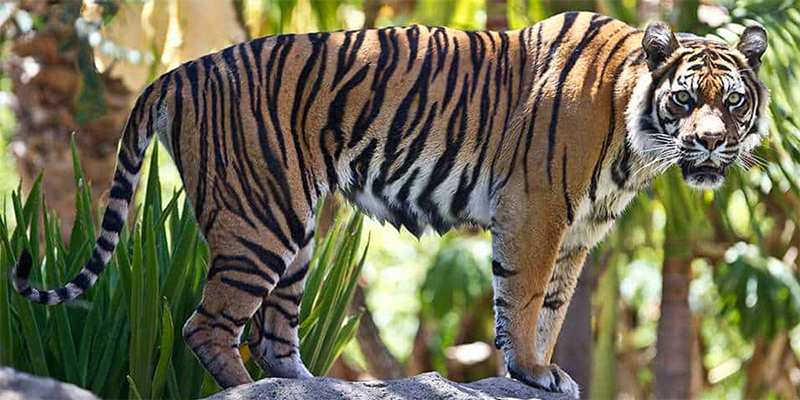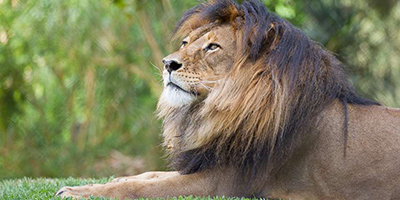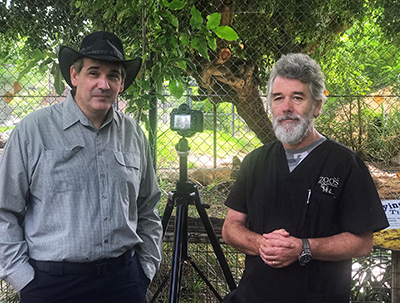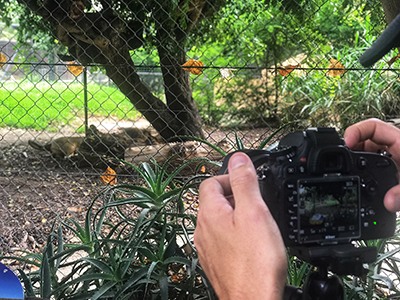How to take a tiger’s pulse with a digital camera
By Candy Gibson
 TECHNOLOGY AND ENGINEERING UniSA researchers have developed a way to remotely monitor animal health. The pilot study included the Sumatran tiger. Photo courtesy Adelaide Zoo.
TECHNOLOGY AND ENGINEERING UniSA researchers have developed a way to remotely monitor animal health. The pilot study included the Sumatran tiger. Photo courtesy Adelaide Zoo.UniSA researchers have developed a new way to undertake basic health checks of exotic wildlife using a digital camera.
 Photo courtesy Adelaide Zoo.
Photo courtesy Adelaide Zoo.Filming animals using a high-resolution digital camera installed on a tripod could offer another way for veterinarians to take an animal’s pulse or check its breathing rate.
In a UniSA pilot study, nine species of Adelaide Zoo’s animals were filmed for three minutes, up to 40 metres away, picking up tiny movements in the chest cavity that indicate heart and breathing rates.
The animals filmed included a giant panda, African lion, Sumatran tiger, orangutan, Hamadryas baboon, koala, red kangaroo, alpaca and a little blue penguin.
 Professor Javaan Chahl and Dr Ian Smith at Adelaide Zoo.
Professor Javaan Chahl and Dr Ian Smith at Adelaide Zoo.UniSA Professor Javaan Chahl, a remote sensing engineer and one of the study leads, says the experiment recorded heart and breathing signals from all the animals.
“The study was done without any physical contact with the animals and without disrupting their daily routine,” Prof Chahl says.
“We showed through this experiment that digital cameras can successfully extract cardiopulmonary signals from the animals in a zoo setting. The technique needs refining and more validation, but it demonstrates that wild animals can be remotely monitored for signs of poor health, allowing for earlier detection of illness and fewer unconscious trips to the vet,” Prof Chahl says.
Adelaide Zoo’s Veterinarian Ian Smith congratulated the researchers.
 Digital cameras can be used to determine cardiopulmonary signals from animals in a zoo setting.
Digital cameras can be used to determine cardiopulmonary signals from animals in a zoo setting.“The study so far looks very promising as a useful tool for monitoring animals both in a zoo setting but also in open range and wild settings,” Dr Smith says.
“We look forward to hearing how the researchers get on with validating and refining their technique.”
A paper about the pilot study has been published in Sensors.
UniSA and Middle Technical University researcher Dr Ali Al-Naji and UniSA PhD student Yiting Tao were key researchers in the study, which was directed by Prof Javaan Chahl, who has a joint appointment with the Defence Science and Technology Group. Dr Ian Smith, Senior Veterinarian for Zoos SA, was also part of the pilot study.
Other Stories
- The exercise that will maximise your heart and brain health
- What is the language of love in the 21st century?
- How to take a tiger’s pulse with a digital camera
- Graduates’ visual handiwork on show for the Oscars
- From the Vice Chancellor
- Achievements and Announcements
- Video: Helping nature recover after Cudlee Creek bushfire
- UniSA offers video gamers a chance to realise their dream jobs
- Students tackle some of life’s big questions in new MOD. podcast
- College graduate returns behind teacher’s desk
- Honouring the ‘voice of cycling’
- Swedish internship gives UniSA students a headstart in defence careers
- Project unearths silent witnesses to history
- Bushfire fundraiser, TDU and more




